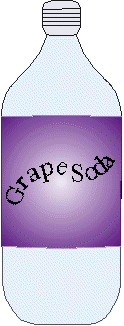![]()
Recommended Age Group: Elementary School
 Guiding
Questions:
Guiding
Questions:1.
What is pollution?
2.
Which liquids
mix with water?
3.
Which liquids won't mix with water?
Each
person or pair needs the following:
1.
2-liter clear bottle
2.
Measuring cup
3.
8 Cups Water
4.
1-1/2 Cups Vegetable oil
5.
1-1/2 Cups Shampoo or Liquid Laundry Detergent
6.
Funnel
7.
Paper towels for any spills
Need
ample elbow room. Spills may happen.
None
Begin
experiment by asking the guiding questions:
1.
What is pollution?
Share ideas about examples of pollution. Then try to come up with a definition.
Help them see that pollution is making something dirty or unsafe for life. Lead
into thinking about water pollution. Talk about our oceans, lakes, rivers, and
streams. What have they heard or read about pollution in these water bodies? Do
they ever think about whether or not the water they swim in is safe? Have they
ever been concerned about the fish we eat being poisoned and harmed from living
in polluted water?
2.
Which liquids mix with water?
One big problem is that too often our oceans, lakes, rivers and streams can look
like they are safe and clean when in fact they are not. Some of the solids and
liquids we are dumping into water will mix up with the water so we cannot see
them with just our eyes. Some things we put into water will not mix and we can
see evidence that they are there. What we cannot see is a big problem!
3.
Which liquids won't mix with water?
Today we will do an experiment by making an "ocean in a bottle." We
will try mixing different liquids with water to see what will and will not mix.
In particular, we will see if oil or detergent will mix with water. Do you think
we should drink in water with oil and/or detergent in it? Are these two liquids
harmful to plant life, fish or other creatures? Oil and detergents are two
common liquids that get dumped into our waters.
1.
Make a "bottle ocean"
Each student or pair should put 3 cups of water into their clean 2-liter bottle.
This is like a little ocean, lake, river, or stream.
2.
What happens when oil is mixed with water?
Add 1 cup of oil by pouring it into the bottle via the funnel. Screw top on
bottle. Mix up the liquids by shaking the bottle. Observe what happens. We
observe that oil and water will not mix. We call liquids that will not mix with
each other immiscible. What do you think happens when there are oil spills in
the oceans? How will oil affect the water, the fish, plant life or animals that
live near the water?
You may want to leave the bottle tipped on its side overnight. The next day, see
if the oil settled or not. How would this impact our knowing that oil existed in
an ocean or lake? How would this help us think about cleaning up oil spills?
3.
Remove oil and water mixture and rinse out bottle. What happens when
soaps and detergents are mixed with water? Put 3 cups of water in the clean
2-liter bottle. Add 1 cup of dish soap or liquid laundry detergent via the
funnel. Screw top on bottle. Mix up the liquids by shaking the bottle. Observe
what happens. We observe suds, bubbles and foaming. Do the two liquids combine?
When two liquids will mix with each other, we call them miscible.
You may want to leave the bottle tipped on its side overnight. The next day, is
the detergent still mixed up with the water or did it separate? Can you still
see the foaming and suds? How does this impact our thinking about soapy kinds of
pollution?
4.
What happens when oil and soap are mixed with water?
Empty, rinse and clean the bottle. Add 3 cups of water, 1/2 cup of oil, and 1/2
cup of soap or detergent. Screw on top. Shake the bottle to mix the liquids.
Look at what happens. Can you see evidence of the oil and soap? Observe what
goes on in the bottle over a period of time. You will find that oil will mix
with soap and then with water. This makes it very dangerous for our water
systems. Oil can be present and we don't really see it because it got mixed up
and broken down with soap and water.
Compare this to trying to wash an oily pan after cooking with it. If you try to
use just water, the oil won't come off. But when we add a little dish detergent,
we can get rid of the oil.
Ask
again,
1.
What is pollution?
2.
What liquids mix with water?
3.
What liquids won't mix with water?
Share
how learning about liquids that will and will not mix with water is related to
our concerns about pollution. Can we always see pollution? If some dangerous
liquids will mix with water, how can we clean it up? Listen to ideas,
observations made during the experiments, and concerns to determine whether or
not they understand pollution and the concept of liquids mixing or not mixing
with other liquids.
It
always is a great idea to have them help someone else conduct an experiment. We
really know and understand something when we can share it with others!

1.
Repeat this type of experiment using different kinds of liquids that are
commonly put into our lakes and oceans. See what liquids will and will not mix
with water.
2.
Research to learn more about certain pollutants. Find out where these
pollutants come from, what harm they may cause to life and the water, and how we
are trying to avoid this pollution or clean it up.